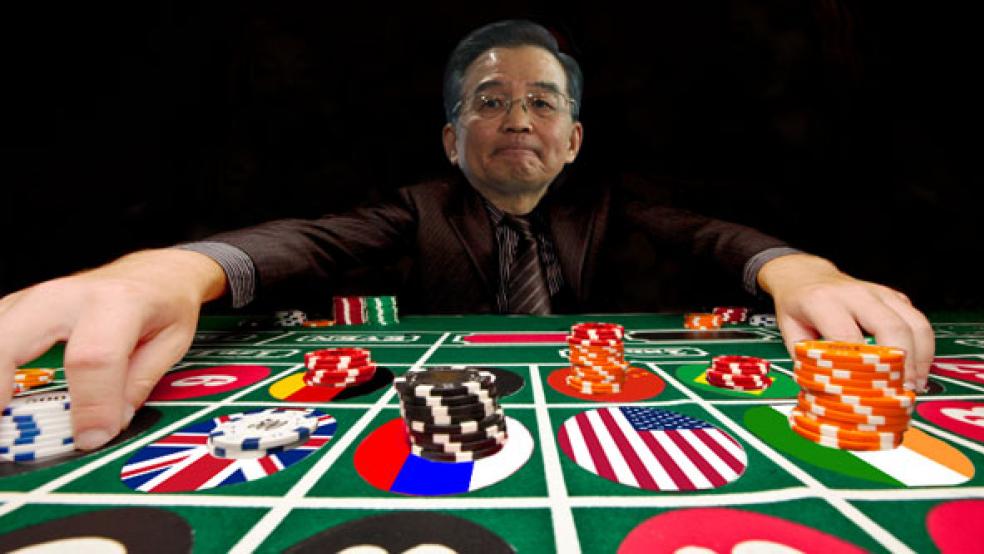Right now we should begin to worry about one of the following:
1. A flood of Chinese money is coming and Americans will react rather badly, as they did when big Japanese investments arrived in the U.S. 20 years ago.
2. A flood of Chinese money is not coming because it will go elsewhere, and Americans will wonder resentfully: “Where’s our flood of Chinese money?”
There is no question, between these two possibilities, that China is among the newly rich of our time--arrivistes, just as the Japanese were by the late 1980s. And like the Japanese, the Chinese have begun to deploy some of their enormous pile of accumulated profits in direct foreign investments abroad.
The story so far is one of big growth from a small base. China’s foreign investments —direct investments in plants, resources, and real estate, not counting its holdings of foreign securities—totaled about $60 billion last year, a fifth of what Americans invested abroad. But a new report, published jointly by the Asia Society in New York and the Wilson Center for International Scholars in Washington, tells the story to come in stark and startling terms. It forecasts that China’s direct investment overseas is likely to exceed $1 trillion—and could reach double that—by the end of this decade.
That’s planet-altering. But questions arise immediately. Where will all the dough go? Will the Chinese follow the Japanese pattern (as they do in so many other cases) and plow it into American assets? The short answers to these momentous matters are these: It’s headed lots of places, and the U.S., though it has already begun to absorb increasing amounts of Chinese capital, cannot count on being among the top-tier destinations.
The authors of the study, Daniel H. Rosen and Thilo Hanemann, are hypersensitive to political considerations prompted by a deep, not altogether rational suspicion of China among Americans. “We conclude that the recent growth of Chinese direct investment in the United States is proof of its great potential,” they write, “but given the parade of political fear-mongering seen so far, those benefits likely will be squandered if steps are not taken to restore clear thinking.”
You can understand their point. Remember the flap over Unocal six years ago? The Chinese National Offshore Oil Corp. prompted congressional investigations when it bid for the California company, and CNOOC eventually walked away. More recently, we had the spectacle of Donald Trump, the presidential apprentice now back to bullying has-beens, piling into the Chinese as if they were about to swallow Manhattan whole.
That’s the kind of thing the Japanese once had to listen to. Don’t look now, but these days Japanese companies with operations in the U.S. employ 700,000 American workers.
Jobs, capital investment, infrastructure improvement: The U.S. needs a lot of each, and Chinese money of the magnitude the Asia Society projects would make a not-inconsiderable difference to the American economy. But as Rosen and Hanemann make plain, Washington will have to get the politics right. Their recommendations include a clear message that Chinese capital is welcome; a simple, systematized process for investment review; and the avoidance of quid pro quo that U.S. companies must enjoy exactly the same privileges in China that Chinese companies enjoy here. “Do not play the reciprocity game,” they write.
True enough, there are things Americans can do to make the U.S. a more hospitable place for Chinese companies to invest. But of equal concern are factors over which neither Washington nor any well-intentioned state or municipality has much control.
The U.S. was clearly a logical focus for the Japanese as they set about building their portfolios of international capital assets. But that was then, and the following points are true now:
- The wave of Japanese investment in the U.S. came in a context that does not apply to the Chinese. Tokyo was (and remains) safe and dry under the U.S. security umbrella, inducing a certain loyalty and identity. The Chinese hold their own umbrella. Still, while I would strenuously dismiss any thought of dangerous enmity between Beijing and Washington, the political ties are not welded so tightly that the U.S. is an automatic place to put Chinese money. It isn’t.
- Southeast Asia is more advanced as a manufacturing site than it was two decades ago, and China’s relations with the region are far denser, commercially and culturally, than Japan’s are even now.
- The Japanese got nervous when their moment came to internationalize the yen. But surely and not so slowly, China is liberalizing the yuan. This is one signal—as if we need another—that staying in dollars, as the Japanese were happy enough to do, is not high on China’s list of favorite things to do. The euro is already a competitive reserve currency; in not so many years the yuan will be another one. Dollar-denominated investments, in short, are in for ever-tougher competition.
- The Japanese had an almost sentimental liking for big U.S. assets—hence the trophy purchases such as Columbia Pictures and Rockefeller Center. There’s no such equivalent impulse for the Chinese. They’re into securing resources (Africa, Australia, Latin America) and acquiring technological knowhow (the U.S. but also Europe). Equally, Chinese manufacturing is at a far lower skill and quality level than Japan’s was in the 1980s; as it is now, its technology is better suited for other middle-income nations (India, Brazil, South Africa).
Americans are in for a tough race as Chinese capital begins to flow in ever-greater amounts. This has implications not only for American jobs and capital investment, but also (and even more worrisome) for the long-term value of the dollar.
Two of the pillars that support the dollar as the leading reserve currency are the dollar-denominated global oil market and currency pegs across the Pacific: Practically every nation in Asia has a mechanism by which its currency floats within a band (declared or implicit) against the dollar. As China invests, either via euros or directly with yuan once they are holdable as reserves, the tipping point many of us have long dreaded may come closer—that moment when the dollar follows the postwar pound and heads gradually south, never to regain its former glory.
Related Links:
An American Open Door? (Asia Society/Kissinger Institute/Woodrow Wilson International Center for Scholars)
The Internationalization of the [Yuan] (Asia Society)
China April Foreign Direct Investment Up 15.2% At $8.46 Billion (Wall Street Journal)






